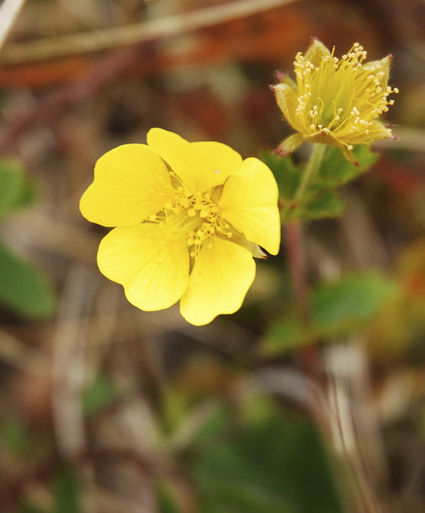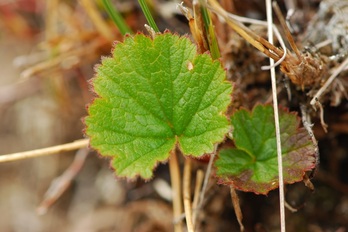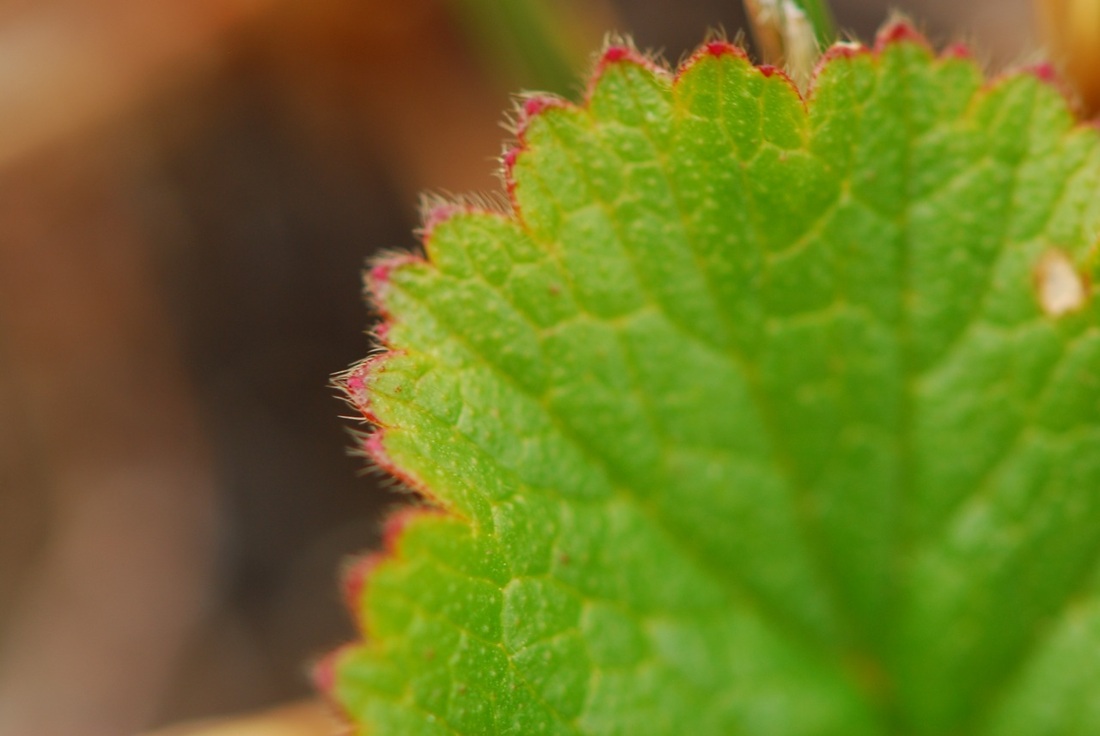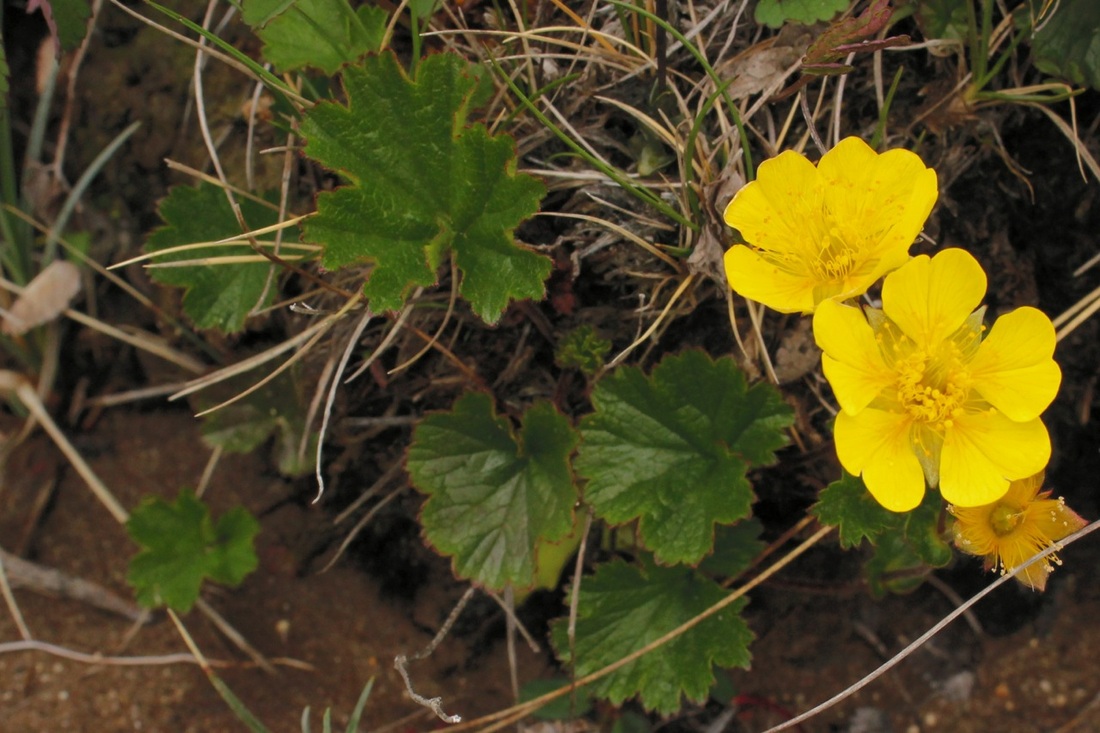Caltha-leaved avens, calthaleaf avens • Geum calthifolium
Identification
Caltha-leaved avens is a perennial wildflower with hairy stems and leaves, that grows to 30 cm tall from a branching rhizome. The basal leaves (growing right from the base of the stem) grow on stalks up to 25 cm long, while the stem leaves are unstalked and attach directly to the stem. The basal leaves are kidney or circular and coarsely toothed, while the stem leaves are lobed and also coarsely toothed. The bright yellow flowers have five heart-shaped petals and grow on hairy stalks. The flowers measure up to 2 cm across, and grow singly or in pairs.
Habitat & Range
Caltha-leaved avens inhabits wet areas, including bogs, wet rocky slopes, and meadows from low to alpine elevations. It is not a common species on BC's west coast, but can be locally abundant. Its range extends north to Alaska and the Yukon Territory, and across the Pacific Ocean to East Asia.
Similar Species
At first glance, caltha-leaved avens can appear similar to villous cinquefoil (Potentilla villosa). Villous cinquefoil has woolly, compound leaves that always grow in threes, and is found in drier habitats and open areas. Large-leaved avens (Geum macrophyllum) is also somewhat similar, but is a much taller plant (to 1 m tall) and has oblong rather than heart-shaped petals.
Human Uses
The name 'avens' is derived from either old French (avence) or medieval Latin (avancia), both with roots in the Greek word for 'antidote;' avens species were thought to protect one from evil spirits, the devil, and other beasts. 'Caltha-leaved' and calthifolium refer to the similarity of this species' leaves to some Caltha species.
Caltha-leaved avens is a perennial wildflower with hairy stems and leaves, that grows to 30 cm tall from a branching rhizome. The basal leaves (growing right from the base of the stem) grow on stalks up to 25 cm long, while the stem leaves are unstalked and attach directly to the stem. The basal leaves are kidney or circular and coarsely toothed, while the stem leaves are lobed and also coarsely toothed. The bright yellow flowers have five heart-shaped petals and grow on hairy stalks. The flowers measure up to 2 cm across, and grow singly or in pairs.
Habitat & Range
Caltha-leaved avens inhabits wet areas, including bogs, wet rocky slopes, and meadows from low to alpine elevations. It is not a common species on BC's west coast, but can be locally abundant. Its range extends north to Alaska and the Yukon Territory, and across the Pacific Ocean to East Asia.
Similar Species
At first glance, caltha-leaved avens can appear similar to villous cinquefoil (Potentilla villosa). Villous cinquefoil has woolly, compound leaves that always grow in threes, and is found in drier habitats and open areas. Large-leaved avens (Geum macrophyllum) is also somewhat similar, but is a much taller plant (to 1 m tall) and has oblong rather than heart-shaped petals.
Human Uses
The name 'avens' is derived from either old French (avence) or medieval Latin (avancia), both with roots in the Greek word for 'antidote;' avens species were thought to protect one from evil spirits, the devil, and other beasts. 'Caltha-leaved' and calthifolium refer to the similarity of this species' leaves to some Caltha species.
References
Pojar, J. and MacKinnon, A. (2005). Plants of Coastal British Columbia, Revised. Vancouver, BC: Lone Pine Publishing. P. 185.
Geum calthifolium Menzies ex Sm. calthaleaf avens; caltha-leaved avens. In Klinkenberg, Brian. (Ed.). E-Flora BC: Electronic Atlas of the Plants of British Columbia. Lab for Advanced Spatial Analysis, Department of Geography, University of British Columbia, Vancouver. Accessed on 23/04/2013.
Authors and editors of page
Chanda Brietzke, Kelly Fretwell, and Brian Starzomski (2016).
Pojar, J. and MacKinnon, A. (2005). Plants of Coastal British Columbia, Revised. Vancouver, BC: Lone Pine Publishing. P. 185.
Geum calthifolium Menzies ex Sm. calthaleaf avens; caltha-leaved avens. In Klinkenberg, Brian. (Ed.). E-Flora BC: Electronic Atlas of the Plants of British Columbia. Lab for Advanced Spatial Analysis, Department of Geography, University of British Columbia, Vancouver. Accessed on 23/04/2013.
Authors and editors of page
Chanda Brietzke, Kelly Fretwell, and Brian Starzomski (2016).








